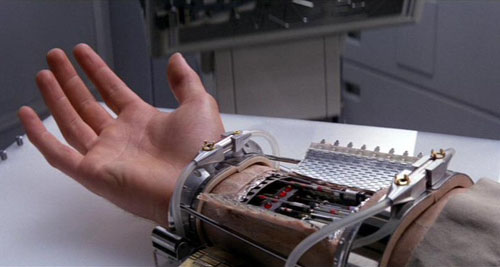I am always amazed that the developments in robotics that are happening in my lifetime. I wish that Isaac Asimov had lived just a bit longer so he could see what the industry is producing today. Sarcos has made the prototype, which is under development in Japan. This robot can recover from pushes intended to topple it over. I’m sure a lot of you have seen the video of the ASIMO robot falling down some simple steps. This new robot with flexible joints and advanced balancing system appears to be the next generation of humanoid robots. For more information, including a video demonstration, check out the full article at NewScientistTech. Found via SlashDot
Flexible joint robot by Sarcos puts Honda’s ASIMO to shame
Related Post
Kevin Warwick wants to be a CyborgKevin Warwick wants to be a Cyborg
Remember at the end of The Empire Strikes Back where Luke gets his hand chopped off by Vader? During one of the closing scenes, a robot doctor finishes up installing a replacement hand for Luke.
Kevin Warwick did something similar as an experiment, but without the whole getting his hand chopped off step. Instead he put an electrode in his hand that could transmit commands to a robotic hand through radio waves. This was done back in 2002, and somehow I never heard of it. I’m sure Ray Kurzweil would be proud. Check out the video below for more information about how he did this, and some other advances like using rat brain cells to power robots. If you are at all interested in robotics, cyborgs, or AI, you’ll be in for a treat.
Amazing agile flying machines from ETH ZurichAmazing agile flying machines from ETH Zurich
I just ran across a cool video of a flying robot playing Jingle Bells on an electric piano. The tempo seemed a bit off, so I clicked through to YouTube to see if there were any more videos. A link for how it works popped up, so naturally I clicked it. Base off of the video, it looks like a human was controlling the robot, so not as impressive as I initially thought. They show some background on “co-pilot” routines that assist the human controllers to keep them from making mistakes. I find this interesting because eventually with AI, these little machines could be completely automated. This reminds me of the creepy surveillance robots from Dark Angel. With special routines to keep these from bumping into obstacles, I can definitely see them flying around our cities sometime in the near future. If you want to see the Jingle Bells video, click through the via link at the bottom. I found this video more interesting though.
via Geekologie
Real world Lightsabers coming soon!Real world Lightsabers coming soon!
A few years ago, the Science Channel aired an episode of SciFi Science, “How to Build a Lightsaber” hosted by theoretical physicist Dr. Michio Kaku. He explained some theories that might be used and developed a rough design that should be “workable in our lifetimes.” Of course almost all of his episodes end up with that qualification. Last month it looks like there was a breakthrough in the hardest part of making a lightsaber work, getting the blade to stop at a certain point.
Although the most prominent uses for controlling the depth of laser cutting are surgical and clinical, Fraser said the team is “very excited about the potential industrial applications,” especially since compared to clinics it’s easier to get new technology into industries.
Unfortunately, the goal is to make the lasers useful surgery, not chopping off alien arms at cantinas.
Via National Post
If you’d like to watch the episode I’m referring to, use this Google Search: How to build a light saber on Youtbue
